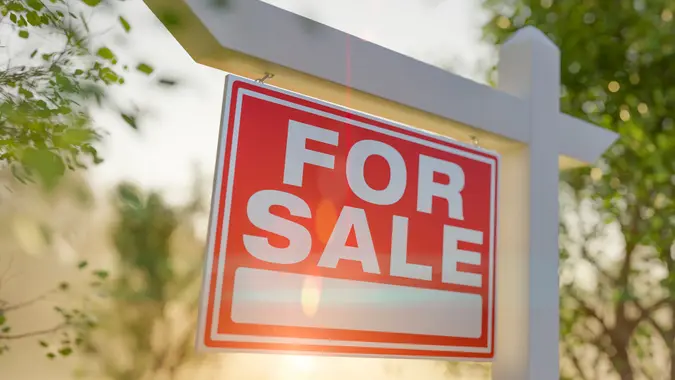A Beginner’s Guide to Buying Your First Home

Commitment to Our Readers
GOBankingRates' editorial team is committed to bringing you unbiased reviews and information. We use data-driven methodologies to evaluate financial products and services - our reviews and ratings are not influenced by advertisers. You can read more about our editorial guidelines and our products and services review methodology.

20 Years
Helping You Live Richer

Reviewed
by Experts

Trusted by
Millions of Readers
First-time buyers often face a number of obstacles to purchasing their home. With an average age of 38, according to the National Association of Realtors, first-time homebuyers are 23 years younger than the average repeat buyer.
That younger age may correlate with comparatively lower income, limited credit history and difficulty saving enough money for a down payment and closing costs. That’s why federal, state and local governments as well as mortgage lenders offer special programs, loans and incentives to help put renters on the path to homeownership.
Understanding the Basics of Home Buying
What Does It Mean to Be a First-Time Homebuyer?
A first time homebuyer is typically someone who has never owned a home before — but you might still qualify even if you’ve owned property in the past.
According to the U.S. Department of Housing and Urban Development (HUD), you’re considered a first-time buyer if you haven’t owned a primary residence in the last three years. This status can qualify you for special loans and assistance programs.
Why Homeownership Matters
Homeownership has long been one of the best paths to building wealth for Americans. Instead of paying rent, your monthly mortgage payments go toward owning a valuable asset. It also offers more stability and freedom to customize your space, invest in your neighborhood and plan for the future.
Preparing Financially for Your First Home
Saving for a Down Payment
The standard down payment for a home is 20%. This means if you’re looking at buying a house that costs $400,000, you should try to save up at least $80,000 as a down payment. For starters, this will allow you to avoid private mortgage insurance, which lenders require for most down payment amounts below 20%. Putting that much down on your house will also immediately build up your equity and prevent you from falling “underwater” with a market downturn.
Here’s what to keep in mind when saving for a down payment:
- Start saving as early as possible, since it can take time to build a sizable down payment.
- “Pay yourself first” by directing money to your housing fund before spending on discretionary items.
- Use a high-yield savings account to grow your down payment — it’s FDIC-insured, fully liquid, and earns more interest than a traditional savings or checking account.
Checking and Improving Your Credit Score
One of the best ways to save money when you buy a house is to have a good credit score. The higher your credit score, the lower your home mortgage interest rate will be — and the savings can be signficant.
Imagine, for example, that you’re taking out a 30-year fixed mortgage on a $400,000 home with an $80,000 down payment. With a good credit score, you may be able to get a mortgage rate of about 6.5%, resulting in monthly payments of $2,022.62. But if you have bad credit and can only get a loan for 9%, that monthly payment will jump to $2,574.79. Even worse, the total interest you pay over the course of the loan will skyrocket, from $408,142.36 to $$606,925.25.
To boost your credit, pay all of your bills on time for as long as possible before you apply for a loan. Refrain from opening numerous new credit card accounts and keep your debt levels as low as possible. While 0% is ideal, maintaining a credit utilization below 30% is critical.
Understanding Your Budget
One common mistake first-time homebuyers make is finding their dream house before they make a realistic budget. But without honestly assessing what you can afford, you might be setting yourself up for financial ruin.
Typically, financial planners recommend spending no more than 30% on all of your housing costs. This includes some items that are commonly overlooked by first-time homebuyers, including maintenance, insurance, HOA fees (if applicable), and property taxes.
Exploring Mortgage Options for First-Time Buyers
Types of Mortgage Loans
Conventional loans
An FHA mortgage is a mortgage loan insured by the Federal Housing Administration. This government-backed loan program is a popular choice for first-time borrowers because you don’t need a big down payment or high credit score to qualify. Plus, you can receive up to 6% in closing costs from a third party. And unlike the conventional loans backed by Freddie Mac and Fannie Mae, there are no income restrictions. However, the property must meet the Department of Housing and Urban Development’s standards for safety and habitability.
- Down payment required: 3.5% with a credit score of 580 or higher; 10% with a credit score of 500 to 579
- Minimum credit score: 500
- Income restrictions: None
- Homeownership counseling: Encouraged but not required
If you’re an active-duty military member, a veteran or a family member of an eligible individual, you can use a VA-guaranteed mortgage to buy a home with no money down — unless the home costs more than you’re approved for or its appraised value is less than the purchase price. The Department of Veterans Affairs places no restrictions on home value or income, and while lenders are free to impose their own credit score requirements, the VA has none.
- Down payment required: None
- Minimum credit score: Set by lender
- Income restrictions: None
- Homeownership counseling: Not required
First-Time Homebuyer Programs
USDA Loan
The U.S. Department of Agriculture guarantees loans for low- and moderate-income buyers who purchase a home in a location designated “rural.” The department uses that term liberally — outlying suburban areas often qualify. Borrowers can use a USDA loan to purchase with no money down and roll closing costs into the loan. While you do have to demonstrate the ability to manage debt, there is no minimum credit score requirement other than the one imposed by your lender.
- Down payment required: None
- Minimum credit score: Varies by lender
- Income restrictions: Vary by location; program map is located on the USDA website
- Homeownership counseling: Recommended but not required
Section 184 Indian Home Loan Guarantee Program
The Section 184 Indian Home Loan Guarantee Program helps American Indian and Alaska Native families, villages, tribes and tribally designated housing entities purchase a home on or off native land. You can use the loan for an existing home or new construction. The loans are available to buyers in participating tribes who purchase a home in a select area through an approved lender. You can find more information to help you determine your eligibility on the program’s webpage.
Good Neighbor Next Door
Good Neighbor Next Door is a HUD program that gives law enforcement officers, teachers (pre-K through 12th grade), firefighters and emergency medical technicians discounts of up to 50% on the purchase of an eligible home in a select revitalization area. The discount is a second mortgage that you only have to repay if you fail to live in the home as your primary residence for at least three years.
State Loan Programs
The preceding loan programs are all backed by organizations, agencies and departments that operate at the federal level. But many states also have loan programs for first-time or low-income borrowers. The loans often work in conjunction with state-provided down payment and/or closing cost assistance.
You’ll find information on your state’s housing department website. Here are examples of the kinds of loans states make available:
- Iowa: Lower-income Iowa residents can purchase a home with 3% down, sometimes with reduced-price mortgage insurance coverage.
- Maryland: Maryland has several loans, including the low-interest MMP 1st Time Advantage loan and the MMP Flex loan that provide secondary financing for the down payment and closing costs.
- Nevada: Nevada’s Home Is Possible loan offers first-time homebuyers competitive rates and interest-free down payment assistance.
- New York: The State of New York Mortgage Agency offers low-interest mortgage loans to qualified first-time buyers.
- Tennessee: The New Start Loan Program helps very-low-income and low-income Tennesseans build a primary residence in Tennessee.
- Texas: The My First Texas Home program is a low-interest 30-year loan with up to 5% interest-free down payment assistance. The program allows borrowers to work through this program to obtain an FHA, VA or USDA mortgage.
Lender Programs
Some lenders, including many of the largest banks, have their own proprietary loans for first-time homebuyers. As with state loans, lenders often make loans available as part of a wider program to assist first-time and/or low-income borrowers. Here are a few that could help you finance your first home purchase:
- Bank of America Affordable Loan Solution mortgage: This is another 3%-down loan, and you can borrow up to $726,200 — $1,089,300 if you put down 5% or more.
- Chase DreaMaker mortgage: This Chase loan requires just 3% down and has flexible credit requirements and income limits.
- Wells Fargo Dream Plan Home mortgage: This loan requires 3% down, and if you’re eligible, you could qualify for up to $5,000 toward one-time closing costs.
- PNC Community Mortgage: This PNC-exclusive loan lets you buy with 3% down, only $500 of which must be your own funds. Remarkably, this loan has no mortgage insurance requirement.
Habitat for Humanity
Habitat for Humanity builds homes for those with a demonstrated need for safe, affordable housing. The program is for prospective homeowners with very low income — not more than 60% of the median income in the area where the home will be located.
The prospective homeowner partners with Habitat throughout the entire process. You contribute sweat equity by participating in the construction of your home or the home of another Habitat home recipient, or by working in a Habitat for Humanity ReStore. And, of course, you must be able to pay an affordable mortgage with payments limited to 30% of your gross monthly income. The payments go back into the Habitat program to help provide more homes.
Choosing the Best Mortgage Lender
The best mortgage lender for you is the one that offers the best combination of price and service. A low mortgage interest rate is certainly a critical part of the homebuying process, but you’ll also want to work with a lender that puts you in the right loan and is easy to communicate with. Once your loan is set up, it essentially runs on auto-pilot, but getting to that stage can be fraught with complicated and difficult issues. You’ll want to work with a lender that makes the whole process easy for you.
The Home Buying Process Step-by-Step
Getting Pre-Approved for a Mortgage
It’s nearly essential in the current market to get pre-approved for a mortgage. It also makes the homebuying process much quicker and signals to the seller that you’re a serious buyer.
You can get pre-approval from your bank by completing a full mortgage application. While you might not yet know the details of your transaction, the bank will review your financial information, such as your earnings, cash on hand and debt levels to determine if you’re in the position to afford a mortgage of a certain dollar amount.
Once you’re pre-approved, the ball can start rolling fast after you find the property you want to buy.
Finding the Right Real Estate Agent
The right real estate agent can not only make the homebuying process much easier for you, but you’re also more likely to find the right house for you at the right price. A good real estate agent is intimately familiar with the local real estate market, including what homes are available, what properties are about to come on the market and what a good price is in the curent market.
Some questions you might want to ask potential agents include:
- How long have you worked in the current market?
- How many homes have you sold?
- Do you have any references?
- Do you work with a team?
- What’s the state of the current market?
- What qualifications do you have?
- What’s your commission fee?
House Hunting Tips
Just as it’s important to draft a realistic budget before you go home shopping, it’s also a good idea to figure out exactly what you do and do not want in your new home. To help prevent yourself from overspending, sort your wishes into “needs” and “wants.” If you’re not armed with this information, you might be seduced by more expensive homes that appeal to your “wants” instead of your “needs.” The ideal home will have the vast majority of your “needs” and a good number of “wants” as well, all within your price range.
To help get an idea of the types of homes that fall into your price range, it’s worthwhile to attend open houses and virtual tours. This can help keep the house hunting process realistic.
Making an Offer and Negotiating
If you’ve found a home you really want, it pays to come in with a strong offer. This is especially true in a competitive housing market. A strong offer is one that is at or near the offering price — or perhaps higher, in some cases — that includes some extras that others may not offer. For example, you might put up more earnest money, waive some contingencies, limit your requests for repairs or include an escalation clause, which indicates your willingness to match any competing offers that come in.
In many cases, even with a strong offer, you should expect a counteroffer from the seller. This may come in the form of a “take-it-or-leave-it” offer or there may be room for further negotiation. A good agent can help you find out if there are other competing offers and if your bid is strong or not.
Navigating the Closing Process
Home Inspections and Appraisals
A home inspection protects you in case there are any issues with your home. Inspections are particularly important for finding problems that are not readily visible to the naked eye, such as structural or plumbing issues, or safety issues, such as electrical hazards.
An inspection will investigate the condition of the home from top to bottom, including structural components, appliances, insulation, plumbing, wiring, and other home systems, such as heating/cooling. The inspector will then write a thorough report, complete with extensive photos. In addition to the peace of mind that a home inspection can offer, buyers can also use the inspection to negotiate various concessions or repairs from sellers.
Finalizing Your Mortgage
When it’s time to finalize your mortgage, your lender and escrow company will provide you with an extensive pile of documents to review. This is your last chance to review your loan terms and ensure that you’re getting exactly what you agreed upon throughout the negotiation process. The final paperwork will also outline all of the closing costs that you’ll be expected to pay, which is usually quite an extensive list. According to Rocket Mortgage, these are just some of the closing costs you may encounter:
- legal fees
- courier fees
- credit reporting fee
- closing fee
- title insurance
- loan origination fee
- recording fee
- transfer tax
Signing the Paperwork
Signing mortgage paperwork can be daunting, as it’s usually quite extensive. According to Maple Tree Funding, some of the papers you may be expected so sign include the following:
- property transfer forms
- mortgage application
- the mortgage itself
- closing disclosure
- promissory note
- escrow documents or waivers
However, you may encounter many additional forms as well. The best way to have a smooth closing day is to work with a good real estate agent and escrow company who can ensure that all of the necessary documents are ready to go and highlighted where you need to sign.
Moving Into Your New Home
Preparing for the Move
Once you’ve signed the paperwork, congratulations! Now it’s time to deal with the realities of actually moving in. Create a moving checklist so that you don’t overlook any important steps. You can get a template for this checklist from a moving company website, even if you decide to DIY instead of hiring professionals.
Some of the things you won’t want to overlook include:
- Sorting, decluttering, packing and labeling items
- Setting a budget
- Separating valuables
- Change of address
- Refilling prescriptions
- Ordering supplies
- Returning things that are not yours
Settling In
Once you arrive at your new house, you’ll have to handle the details that make it a functioning home. This includes setting up utilities, internet, cable and so on. This is also the time to introduce yourself to your neighbors.
Maintaining Your Investment
Regular Home Maintenance
As any homeowner will tell you, the purchase process is only the first step in a lifetime of costs and responsibilities that come with owning a home. Most experts suggest you set aside 1% to 3% of your home’s value for annual maintenance costs. This should be enough to cover everything from seasonal tasks, like spring and fall gutter cleaning or dryer vent cleaning, to ongoing upkeep such as new paint, roof inspections and repairs, and replacement of broken items.
Understanding Homeowners Insurance
Homeowners insurance is a vital component of protecting what is likely the biggest purchase of your entire life. While homeowners insurance is customizable, it typically provides the following coverages, according to Allstate:
- your dwelling
- your personal property
- liability for injuries on your property
Depending on your policy, it will likely cover a variety of specific hazards, from flood and fire to theft, windstorms, hail, lightning strikes and potentially earthquakes and hurricanes.
To choose the right policy, you’ll want to find the right blend of coverage and cost. If you don’t have much by way of possessions or assets, for example, you might not need as much coverage as someone whose home is chock-full of priceless possessions. The reputation and claims-paying ability of the insurance company should also factor into your calculations, along with the size of your deductible.
The information related to the Chase DreaMaker mortgage was collected by GOBankingRates and has not been reviewed or provided by the issuer of this product. Product details may vary. Please see the issuer’s website for current information. GOBankingRates does not receive commission for this product.
Our in-house research team and on-site financial experts work together to create content that’s accurate, impartial, and up to date. We fact-check every single statistic, quote and fact using trusted primary resources to make sure the information we provide is correct. You can learn more about GOBankingRates’ processes and standards in our editorial policy.
- National Association of Realtors. 2023. "Highlights From the Profile of Home Buyers and Sellers."
- Freddie Mac. "Home Possible."
- USDA. "Single Family Housing Guaranteed Loan Program."
- Department of Housing and Urban Development. "Section 184 Indian Home Loan Guarantee Program."
- Fannie Mae. "FAQs: 97% LTV Options."
- Fannie Mae. "How Much Can I Borrow?"
- Fannie Mae. "You’ve Got Options When It Comes to Home Financing."
 Written by
Written by  Edited by
Edited by 
























